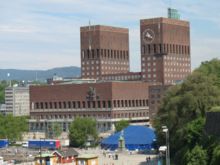Oslo: Difference between revisions
imported>Kjetil Ree No edit summary |
mNo edit summary |
||
| (9 intermediate revisions by 4 users not shown) | |||
| Line 1: | Line 1: | ||
'''Oslo''' (former name '''Christiania''' or '''Kristiania''') is the [[capital]] and largest city of [[Norway]]. The population of Oslo's metropolitan area is 825,105, and the population of the city proper is 538,411.<ref>[http://www.ssb.no/folkemengde_en/tab-2006-02-23-05-en.html The Norwegian Central Bureau of Statistics: ''Population, by sex, age and municipality. Oslo. 1 January 2006'']</ref> | {{subpages}} | ||
'''Oslo''' (former name '''Christiania''' or '''Kristiania''') is the [[capital]] and largest city of [[Norway]]. The population of Oslo's metropolitan area is 825,105, and the population of the city proper is 538,411.<ref>[http://www.ssb.no/folkemengde_en/tab-2006-02-23-05-en.html The Norwegian Central Bureau of Statistics: ''Population, by sex, age and municipality. Oslo. 1 January 2006'']</ref> Oslo has a total area of 454 km². | |||
==History== | ==History== | ||
==Politics== | ==Politics== | ||
[[Image:Oslo City hall.jpg|thumb|220px|The city hall]] | |||
Oslo has seventeen members of the Norwegian parliament. In the term 2005-2009, the following parties are represented: | Oslo has seventeen members of the Norwegian parliament. In the term 2005-2009, the following parties are represented: | ||
| Line 30: | Line 32: | ||
|} | |} | ||
The local system of government is parliamentary. The city council consists of 59 representatives, elected every four years. The executive branch of the local government consists of six commissioners, in addition to the leader of the commission. All seven members of the commission need the confidence of the city council. As of | The local system of government is parliamentary. The city council consists of 59 representatives, elected every four years. The executive branch of the local government consists of six commissioners, in addition to the leader of the commission. All seven members of the commission need the confidence of the city council. As of 2009, the leader of the commission is Mr. [[Stian Berger Røsland]] of the Conservative Party. Mr. Røsland leads a coalition between the Conservative Party and the Progress Party. The current Mayor is Mr. [[Fabian Stang]], also of the Conservative Party. The Mayor of Oslo has a mostly ceremonial role. | ||
The following parties are represented in the city council: | The following parties are represented in the city council: | ||
| Line 62: | Line 64: | ||
==Boroughs== | ==Boroughs== | ||
Oslo is divided into fifteen boroughs | Oslo is divided into fifteen boroughs: | ||
# Gamle Oslo | # Gamle Oslo | ||
| Line 79: | Line 81: | ||
# Nordstrand | # Nordstrand | ||
# Søndre Nordstrand | # Søndre Nordstrand | ||
The boroughs are to some extent self governed, and are run by local councils elected every four years. The boroughs have responsibilities such as running nursing homes and kindergartens. | |||
In addition to the fifteen boroughs, two areas are separate geographical entities, but do not have an administration of their own. These two areas are the city center (“Sentrum”) and Oslo's surrounding rural areas (“Marka”). | |||
==Transport== | ==Transport== | ||
| Line 84: | Line 90: | ||
==References== | ==References== | ||
<references /> | <references />[[Category:Suggestion Bot Tag]] | ||
Latest revision as of 06:00, 30 September 2024
Oslo (former name Christiania or Kristiania) is the capital and largest city of Norway. The population of Oslo's metropolitan area is 825,105, and the population of the city proper is 538,411.[1] Oslo has a total area of 454 km².
History
Politics
Oslo has seventeen members of the Norwegian parliament. In the term 2005-2009, the following parties are represented:
| Party | MPs |
|---|---|
| Labor party | 6 |
| Progress Party | 3 |
| Conservative Party | 3 |
| Socialist Left Party | 2 |
| Liberal Party | 2 |
| Christian Democratic Party | 1 |
The local system of government is parliamentary. The city council consists of 59 representatives, elected every four years. The executive branch of the local government consists of six commissioners, in addition to the leader of the commission. All seven members of the commission need the confidence of the city council. As of 2009, the leader of the commission is Mr. Stian Berger Røsland of the Conservative Party. Mr. Røsland leads a coalition between the Conservative Party and the Progress Party. The current Mayor is Mr. Fabian Stang, also of the Conservative Party. The Mayor of Oslo has a mostly ceremonial role.
The following parties are represented in the city council:
| Party | MPs |
|---|---|
| Labor party | 15 |
| Conservative Party | 15 |
| Socialist Left Party | 12 |
| Progress Party | 10 |
| Liberal Party | 3 |
| Christian Democratic Party | 2 |
| Red Electoral Alliance | 2 |
Boroughs
Oslo is divided into fifteen boroughs:
- Gamle Oslo
- Grünerløkka
- Sagene
- St. Hanshaugen
- Frogner
- Ullern
- Vestre Aker
- Nordre Aker
- Bjerke
- Grorud
- Stovner
- Alna
- Østensjø
- Nordstrand
- Søndre Nordstrand
The boroughs are to some extent self governed, and are run by local councils elected every four years. The boroughs have responsibilities such as running nursing homes and kindergartens.
In addition to the fifteen boroughs, two areas are separate geographical entities, but do not have an administration of their own. These two areas are the city center (“Sentrum”) and Oslo's surrounding rural areas (“Marka”).
